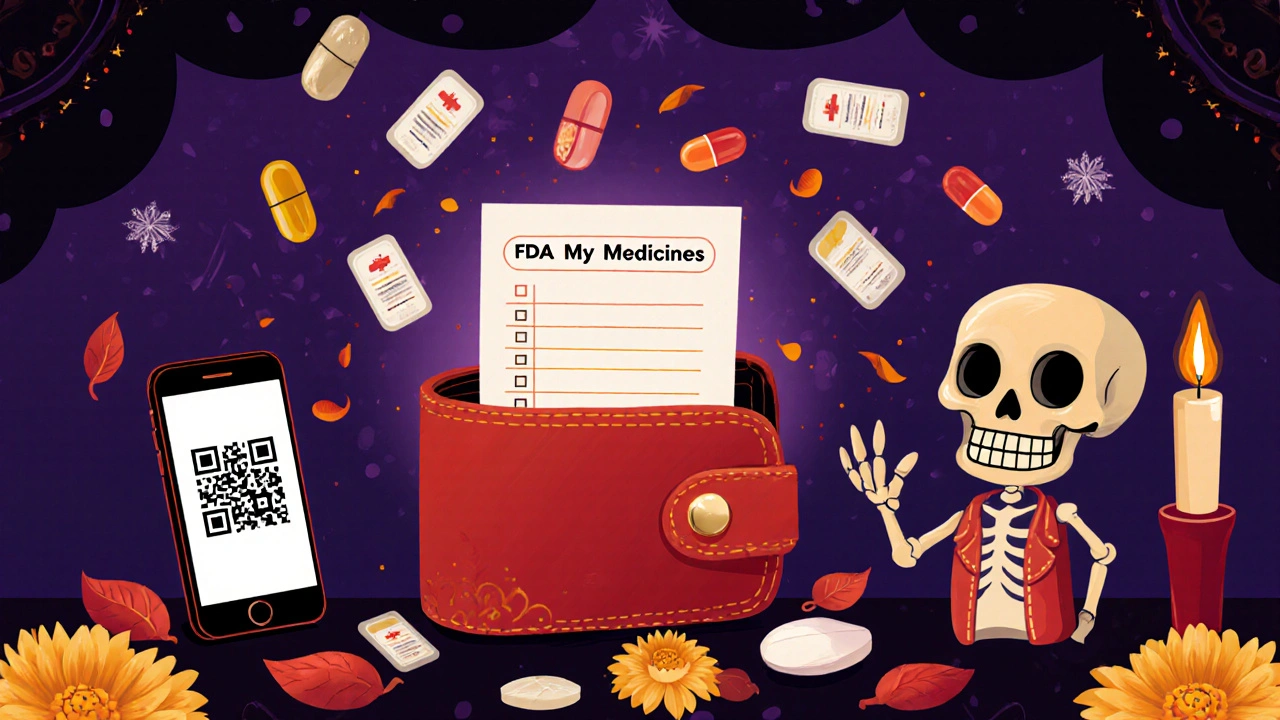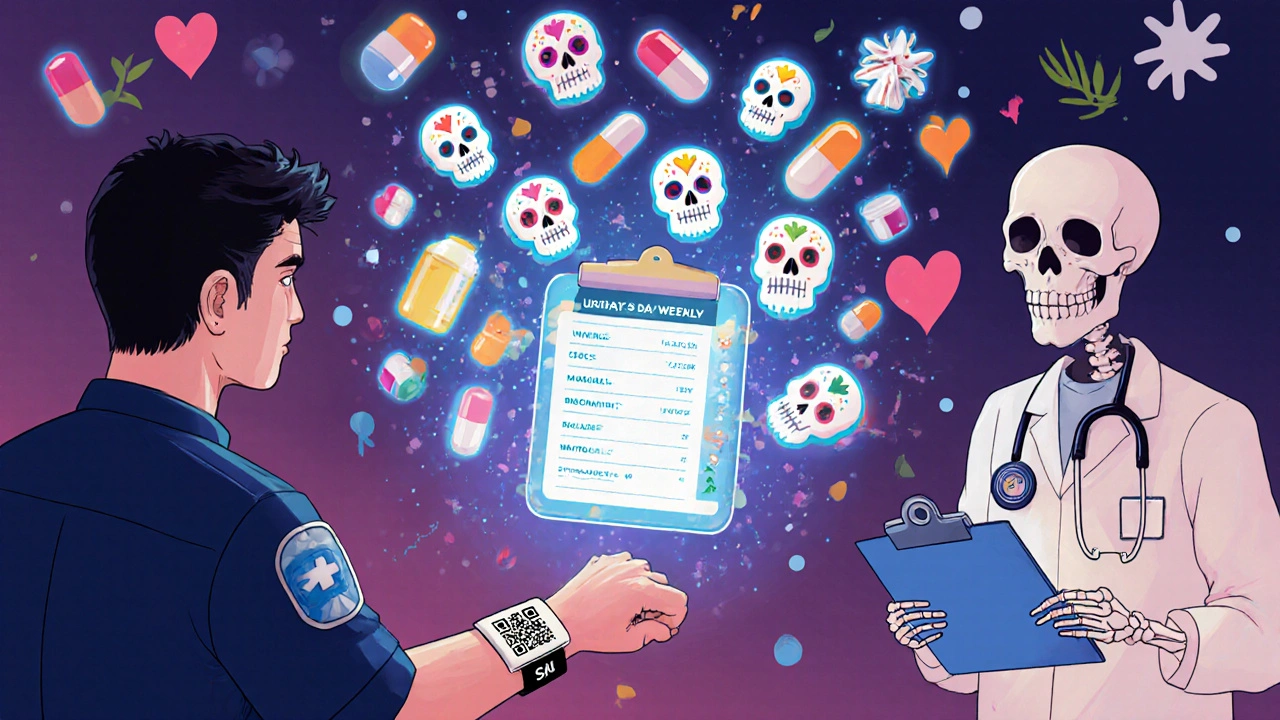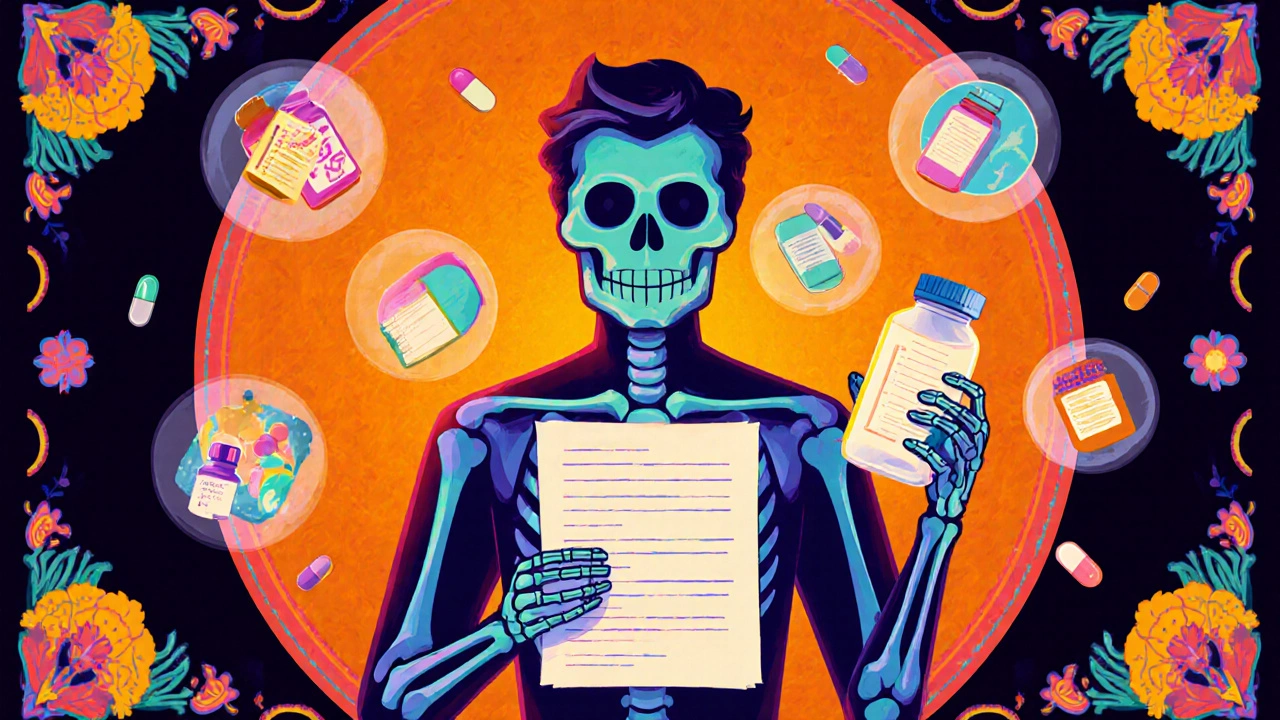Medication List Builder
Add Medication
Your Medication List
No medications added yet
Start by adding your first medication using the form above
Every year, more than 1.5 million people in the U.S. end up in the emergency room because of problems with their medications. Many of these cases aren’t caused by bad drugs - they’re caused by bad information. A simple, updated list of everything you take could have prevented it.
You don’t need to be old or sick to need this. If you take even one prescription, a daily vitamin, or an over-the-counter pain reliever, you’re at risk. Medications don’t just interact with each other - they interact with your body, your diet, your other health conditions, and even your sleep. A missing detail on your list - like that herbal supplement you take for joint pain - could be the reason a doctor prescribes something that makes you dizzy, nauseous, or worse.
What Goes on a Real Medication List
A medication list isn’t just a note in your phone or a scribble on a napkin. It’s a living document that saves lives. Here’s exactly what to include - no more, no less.
- Full name of each medication - both brand and generic. If you take Lisinopril, write it as “Lisinopril (Zestril)” so your pharmacist knows you’re not taking two different pills.
- Dosage - 10 mg, 500 mg, 25 mcg. Don’t say “one pill.” That’s useless if you switch strengths.
- How often and when - “Take 1 tablet by mouth every morning with breakfast,” not “once daily.” Timing matters. Some meds need food. Others can’t be taken with coffee.
- Why you take it - “For high blood pressure,” “for occasional heartburn,” “for anxiety.” This helps doctors spot duplicates or unnecessary drugs.
- Over-the-counter drugs - Tylenol, ibuprofen, antacids, sleep aids. These aren’t “just supplements.” They can cause liver damage, stomach bleeding, or dangerous interactions with blood thinners.
- Vitamins and supplements - Even if you think they’re “natural.” Fish oil thins blood. Vitamin K cancels out warfarin. St. John’s Wort messes with antidepressants and birth control.
- Allergies and bad reactions - Not just “allergic to penicillin.” Say “rash and swelling after amoxicillin” or “severe dizziness after codeine.” Vague answers won’t help in an emergency.
- Physical description of pills - Color, shape, markings. “Round, white, with ‘10’ on one side.” This helps if you lose your bottle or get a different generic brand.
Don’t forget: if you use a pill organizer, write the name and dose on the container itself. That’s your backup when the list gets lost.
Why Your List Must Be Updated Every Time You Change Something
People think they’ll remember what they’re taking. They won’t. Studies show 35% of medication errors happen because the list is outdated.
Imagine this: You stop taking a blood pressure pill because your doctor said you didn’t need it anymore. You forget to tell your new doctor. Two weeks later, you get dizzy, fall, and break your hip. The ER team sees you’re on five other meds - but they don’t know you stopped one. They assume you’re overdosed. You get more drugs. You get sicker.
That’s why you update your list immediately after:
- A new prescription is filled
- A dose is changed
- A drug is discontinued
- You start or stop a supplement
- You switch pharmacies
Set a reminder on your phone: “Update meds” every Sunday. Or better yet - update it right after each doctor visit. Don’t wait.
Where to Keep It - And How to Carry It
A list that’s locked in a drawer is useless in an emergency. You need it with you - always.
Here are three proven ways to keep it accessible:
- Printed copy in your wallet - Fold it small. Keep it in a clear plastic sleeve. If you’re in an accident, paramedics check your wallet first.
- Digital version on your phone - Use the FDA’s free “My Medicines” app, GoodRx, or even a Notes app. Take a photo of each pill label and attach it to the entry. The University of Michigan found this cuts documentation errors by 63%.
- QR code link - The CDC’s 2024 template lets you generate a QR code that links to your digital list. First responders can scan it with their phone and see your full history in seconds.
Don’t rely on your electronic health record. Most doctors don’t have time to pull it up during an emergency. You are your own best advocate. Your list is your safety net.

Who Needs to See It - And When
You don’t just share this with your primary care doctor. You share it with everyone who touches your health.
- Emergency room staff - Always hand it to them when you arrive. Say, “Here’s what I take.”
- Pharmacists - Especially if you use more than one pharmacy. CVS Health says patients who stick to one pharmacy have 37% fewer drug interactions.
- Dentists - Some antibiotics and painkillers interact with heart meds or blood thinners.
- Physical therapists - If you’re on muscle relaxers or sedatives, they need to know why you’re moving slower or feeling foggy.
- Family members or caregivers - If you’re hospitalized or confused, they need to know what you’re on.
Dr. Sarah Ahmed, a geriatric pharmacist, says the most common mistake she sees? Patients forget to mention OTC meds and supplements. That’s 30% of all unexpected reactions.
Tools That Actually Work
You don’t need fancy tech. But if you like tech, here’s what’s proven:
- MyMedSchedule (FDA app) - Launched in March 2024, it uses photo recognition to scan pill labels and auto-fill your list. Accuracy: 92%.
- Pill organizers with alarms - Walgreens’ 2022 study showed a 45% improvement in correct dosing when people used these with a written list.
- GoodRx or Medisafe - These apps send reminders and flag potential interactions in real time.
- Download your EHR list - Thanks to the 21st Century Cures Act, you can pull your full medication history from your hospital’s patient portal. But only 38% of people do it. Do it now.
Still, the simplest method works best: a printed list you update weekly and carry in your wallet.

What Happens When You Do This Right
It’s not theoretical. The Agency for Healthcare Research and Quality found that patients who use accurate medication lists reduce medication errors by 27% during hospital stays.
Think about that. That’s 27% fewer chances of being given the wrong drug, the wrong dose, or a drug that clashes with your other meds.
And it’s not just about avoiding harm. It’s about getting better care. When your doctor knows exactly what you’re taking, they can stop unnecessary drugs. They can avoid prescribing something that won’t work. They can tailor your treatment instead of guessing.
One study estimates that if every American kept an up-to-date medication list, we could prevent 150,000 ER visits every year. That’s $1.2 billion in healthcare savings.
That’s not just data. That’s your life.
Start Today - No Excuses
You don’t need to be perfect. You just need to start.
Right now, open your medicine cabinet. Take out every pill bottle, every box, every supplement. Write down what’s in them - name, dose, why, when. Include the OTC stuff. Include the vitamins. Include the herbs.
Then, write down your allergies. Write down your reactions. Write down what the pills look like.
Print it. Put it in your wallet. Take a photo of it. Send it to your family. Update it next week.
Medication safety isn’t about being perfect. It’s about being prepared. One list. One step. One life saved.


Neoma Geoghegan
November 23, 2025 AT 20:29Just updated my list after my last doc visit. Took 12 minutes. My pharmacist thanked me. That’s all you need to know.
Bartholemy Tuite
November 25, 2025 AT 09:14bro i used to think my fish oil was harmless till i got sent home from the ER with a bleeding ulcer. now i list EVERYTHING. even that ‘natural’ turmeric powder i got off amazon. turns out it’s basically aspirin with a yoga vibe. also, i keep a photo of every pill in my notes app. if i pass out, at least my phone can scream ‘HE TAKES WARFARIN’ to the paramedics.
Sam Jepsen
November 27, 2025 AT 05:10This is gold. I shared this with my mom who’s on 12 meds and she cried. Not because she’s sad - because she finally felt seen. I printed a copy, laminated it, and stuck it in her purse. Now she carries it like a lucky charm. If you’re reading this and you’re not doing this yet - just do it. Today. No excuses.
Yvonne Franklin
November 27, 2025 AT 10:14Don’t forget to note the pharmacy name too. I had a drug interaction because my new doc didn’t know I switched from CVS to Walgreens and they gave me a different generic. Same pill, different filler. I got dizzy for a week. Fix your list, fix your life.
Nikhil Chaurasia
November 28, 2025 AT 17:52In my village in India, we just remember what we take. But after my uncle passed from a hidden interaction between his heart pill and a herbal tea, I realized - tradition doesn’t save lives. Clarity does. I made a list in Hindi and English. Now my whole family uses it.
Holly Schumacher
November 30, 2025 AT 16:37Wow. Someone finally wrote this without sugarcoating it. You know what’s worse than not having a list? Having a list that says ‘vitamins’ and nothing else. That’s not a list. That’s a lie. And if you’re using ‘natural’ as a reason to skip dosage, you’re one bad interaction away from a funeral. Stop being lazy. Start writing.
Michael Fitzpatrick
December 1, 2025 AT 18:51I used to think this was overkill. I’m 32, healthy, only take a daily multivitamin and occasional ibuprofen. But then I broke my ankle and the ER doc asked if I took anything else. I said ‘no’ - forgot about the melatonin I take for sleep. They gave me a muscle relaxer. I spent 3 hours in the ER confused and nauseous. Now I have a laminated card in my wallet. It’s not glamorous. But it saved me from looking like an idiot.
Shawn Daughhetee
December 2, 2025 AT 01:33My grandma died because her list was on a sticky note in her kitchen. They didn’t know she was on blood thinners. She got a flu shot and bled internally. I made a QR code for my whole family. Scan it. See everything. No more guessing. No more ‘I think she took…’
Miruna Alexandru
December 2, 2025 AT 13:25It’s ironic that we’re told to track our meds like a spreadsheet while ignoring the systemic failures that make this necessary. The pharmaceutical industry profits from polypharmacy. The healthcare system incentivizes prescribing over communication. Your list is a Band-Aid on a hemorrhage. But fine. Carry your QR code. Write your pills. Just know - you’re not fixing the system. You’re just surviving it.
Justin Daniel
December 3, 2025 AT 21:06Look I get it. This feels like homework. But imagine if your kid had a sports injury and the ER doc scanned your QR code and saw ‘no allergies, no blood thinners, no supplements’ - and they didn’t have to guess. That’s the win. You don’t have to be perfect. Just be ready. I made mine in 10 minutes. I carry it. I update it. And yeah - I feel like a responsible adult now. Who knew?